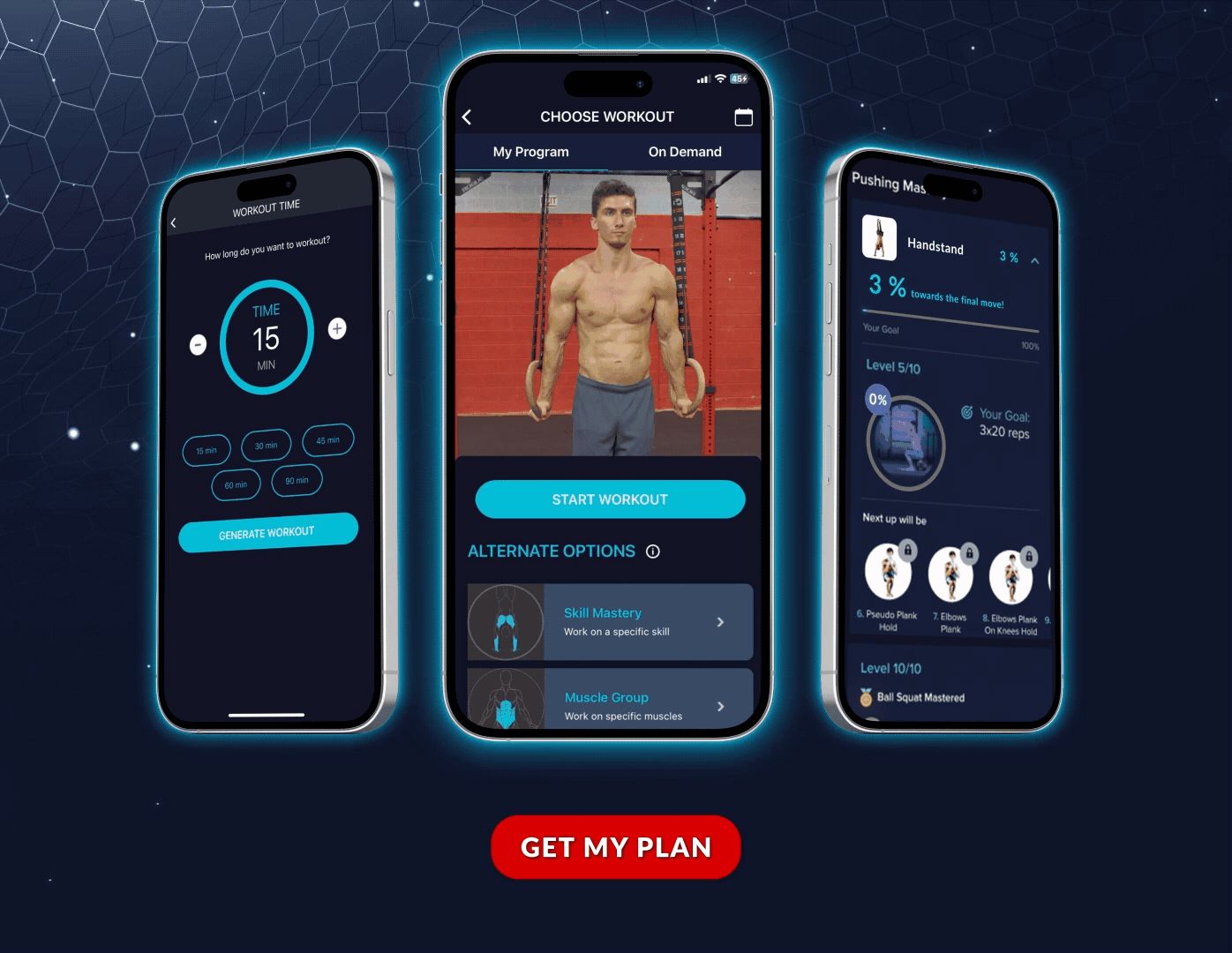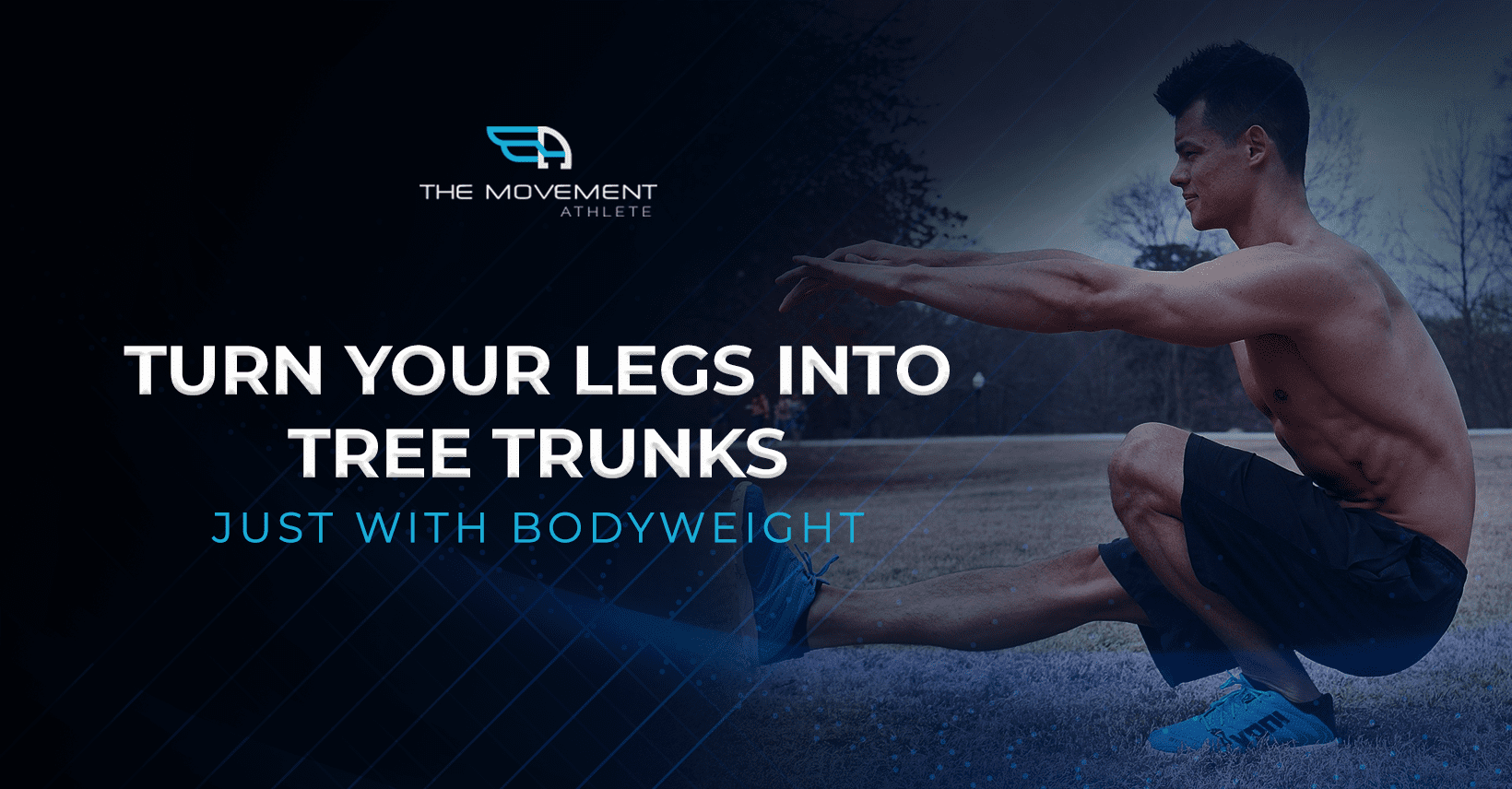
Build Tree Trunk Legs with Bodyweight: Complete Scientific Guide
📖 Read Time: 15 Minutes | ✍️ Written by: TMA Expert Coaches | 🎯 Difficulty: Beginner to Advanced
🏆 Join the Tribe!
Join the tribe of Movement & Calisthenics Athletes – people just like you that are working with their own body weight to get strength, lose fat build muscle, recover from injuries and live their best lives!
Think you can’t build massive, powerful legs without a barbell? Think again. I’m about to show you how bodyweight training can transform your chicken legs into tree trunks – and give you the explosive power most gym rats can only dream of.
⚡ The Shocking Truth About Bodyweight Leg Training
Gymnasts build some of the most powerful legs in athletics using ZERO weights. Their secret? Progressive bodyweight training that challenges muscles in ways barbells never could. Studies show bodyweight training can produce equal or greater strength gains compared to traditional weight training when properly programmed.
📚 Table of Contents
- The Dangerous Stereotype (and Why It’s Dead Wrong)
- Fundamental Principles of Calisthenics Leg Training
- Why Strong Legs Are Non-Negotiable for Athletes
- Training Methods Comparison Chart
- Your 12-Month Progress Timeline
- How to Train Legs for Mass and Endurance
- The Calisthenics Mastery Approach
- 10 Tree-Trunk Building Exercises (With Progressions)
- 3 Complete Workout Programs
- Frequently Asked Questions
The Dangerous Stereotype That’s Holding You Back
Too many people think that legs don’t matter in calisthenics because the most advanced skills are typically hand balancing ones, or arm- and core-strength skills. Think of the handstand, the human flag, the planche, etc.
⚠️ WARNING: Critical Misconception
Ignoring leg training in calisthenics is like building a house on sand. Research shows that 73% of upper body plateaus are directly related to weak lower body development. Your injury risk increases by 4x, and you’ll never achieve true movement mastery without a solid foundation.
Fundamental Principles of Calisthenics
The etymology behind “calisthenics” comes from Greek, “kalli” (beautiful) and “sthenos” (strength). Ideologically, calisthenics wants to help you develop your strength, body and mind holistically, in as complete a manner as possible.
✅ Core Training Principle
If you have a strong upper-body and weak legs, your body isn’t holistically trained. True strength requires balance throughout your entire kinetic chain. Studies from the Journal of Strength & Conditioning show that lower body strength directly correlates with upper body performance in calisthenics athletes.
Why Strong Legs Are Non-Negotiable for Athletes
1. DEVELOP SUPERHUMAN RANGE-OF-MOTION (ROM)
What is ROM? The range through which a joint can be moved – your body’s ability to move freely and fully through all planes of motion.
Quick Test: Try 20 deep squats with heels to butt. Harder than it looks? That’s your ROM calling for help. 80% of adults can’t perform this basic movement pattern correctly.
💡 Pro Tip: Improved ROM increases force production by up to 23% according to biomechanics research.
2. BUILD UNSHAKEABLE BALANCE & STABILITY
The pistol squat isn’t just about strength – it’s about perfect balance maintained throughout the entire movement. Without strong, stable legs, you’ll never progress beyond basic movements.
3. UNLOCK EXPLOSIVE POWER MOVES
Aerials, flips, jumps, flags, planches – they ALL require leg strength. Master your squat progressions, and you’ll unlock movements that most people think are impossible. Leg power is the foundation of 90% of advanced calisthenics skills.
📊 Training Methods Comparison Chart
| Goal | Training Method | Rep Range | Rest Time | Expected Results |
|---|---|---|---|---|
| Mass Building | High volume, slow tempo | 8-15 reps | 45-60 sec | Visible size in 8-12 weeks |
| Explosive Power | Plyometric focus | 3-6 reps | 2-3 min | 30% jump increase in 6 weeks |
| Endurance | Circuit training | 20-50 reps | 15-30 sec | 3x stamina in 4-6 weeks |
| Skill Mastery | Progressive loading | 5-8 reps | 90-120 sec | Pistol squat in 3-6 months |
🚀 Your 12-Month Progress Timeline
🌱 Months 1-3: Foundation Phase
Focus: Basic squat form, mobility work, building work capacity
Milestone: 50 perfect bodyweight squats, improved flexibility
Weekly Volume: 200-300 total reps
💪 Months 4-6: Strength Building
Focus: Single-leg variations, weighted progressions
Milestone: First assisted pistol squat, visible muscle growth
Weekly Volume: 300-500 total reps
🔥 Months 7-9: Power Development
Focus: Jump training, explosive movements
Milestone: Full pistol squat, 30+ inch vertical jump
Weekly Volume: 400-600 total reps + plyometrics
🏆 Months 10-12: Mastery Phase
Focus: Advanced skills, weighted pistols, athletic performance
Milestone: Multiple advanced variations mastered
Results: Tree trunk legs achieved!
How to Train Your Legs🦵 to Build Mass and Endurance
The 4 Commandments for Building Tree Trunks
1. ✅ Multiple Sets Are Mandatory
Aim for 4+ sets with no more than 60 seconds rest. Research shows volume is king for muscle growth – one set won’t cut it.
2. ✅ Target Multiple Muscle Groups
Compound movements that hit quads, hamstrings, glutes, and calves simultaneously. This triggers 3x more growth hormone release.
3. ✅ Minimal Rest = Maximum Growth
Push to near failure without allowing full recovery during the workout. This creates metabolic stress – a key driver of hypertrophy.
4. ✅ Full Range-of-Motion Only
Half reps = half results. Deep squats activate 25% more muscle fibers than partial movements. Go deep or go home.
3 Complete Tree Trunk Workout Programs
🌱 BEGINNER: Foundation Builder
Complete 3 rounds | 60-90 seconds rest between sets
Warm-Up (5 minutes)
• Leg swings: 20 each direction
• Deep squat hold: 3 x 20 seconds
• Walking lunges: 2 x 10 steps
Main Workout
1. Bodyweight Squats: 20 reps
2. Wall Sit: 30 seconds
3. Forward Lunges: 10 per leg
4. Calf Raises: 25 reps
5. Glute Bridges: 15 reps
💪 INTERMEDIATE: Mass Builder
Complete 4-5 rounds | 45-60 seconds rest between sets
Dynamic Warm-Up (7 minutes)
• Jump rope or jogging: 2 minutes
• Dynamic stretches: 3 minutes
• Activation squats: 2 x 15 reps
Main Workout
1. Bulgarian Split Squats: 12 per leg
2. Jump Squats: 15 reps
3. Single-Leg RDL: 10 per leg
4. Box Step-Ups: 15 per leg
5. Pistol Squat Negatives: 5 per leg
6. Walking Lunges: 20 total steps
🔥 ADVANCED: Tree Trunk Protocol
Complete 5-6 rounds | 30-45 seconds rest between sets
Advanced Activation (10 minutes)
• Sprints: 3 x 20 seconds
• Plyometric warm-up: 5 minutes
• Skill-specific prep: 2 minutes
Main Workout
1. Pistol Squats: 8-10 per leg
2. Depth Jumps: 6 reps
3. Shrimp Squats: 8 per leg
4. 180° Jump Squats: 10 reps
5. Single-Leg Box Jumps: 5 per leg
6. Nordic Curls: 8 reps
7. Weighted Lunges: 15 per leg
8. Max Height Jumps: 8 reps
The Calisthenics Mastery Approach
If your goal is true calisthenics mastery, your training takes on a different dimension. This approach focuses on pure skill-work and mastery of progressive movement patterns.
💡 Master’s Secret: The Pistol Squat
The pistol squat is the ultimate test of leg strength, balance, and mobility. It reveals every weakness in your lower body and provides the blueprint to fix them. Studies show mastering the pistol squat improves overall athletic performance by up to 40%.
10 Tree-Trunk Building Bodyweight Exercises (With Video Demos)
1. ASSISTED SQUAT (Foundation Level)
Purpose: Build foundation strength and perfect form before advancing
Primary Targets: Quadriceps, hamstrings, glutes, core
Key Point: Use minimal support – this isn’t about hanging on!
Common Mistake: Over-relying on arms instead of leg drive
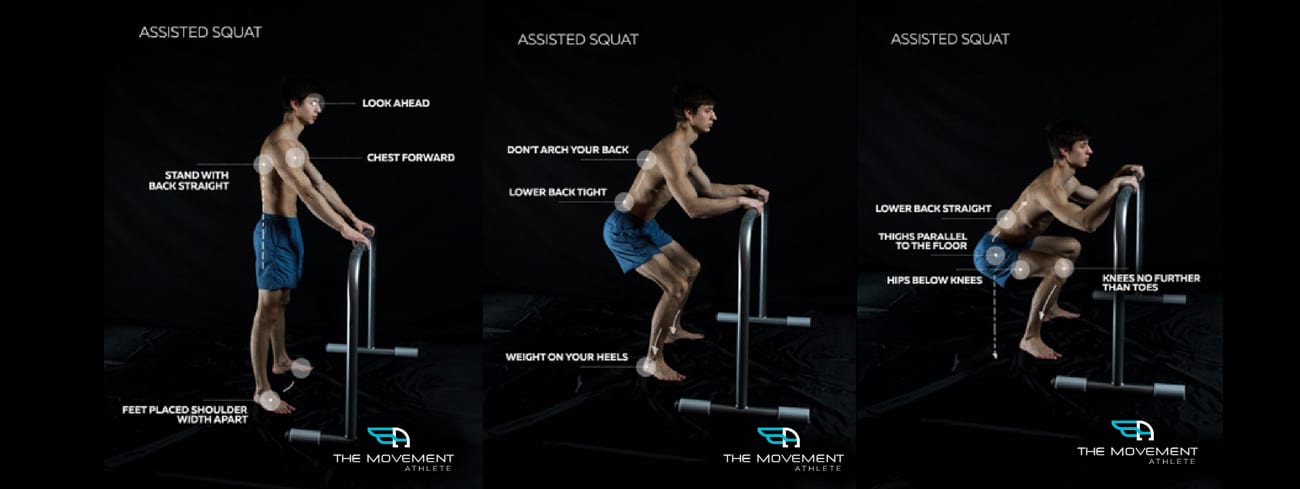
Step-by-Step Execution:
• Hold stable object (pole, TRX, door frame) at arm’s length
• Feet shoulder-width apart, toes slightly out
• Initiate with hips back, knees tracking over toes
• Lower until thighs parallel to floor (or deeper)
• Drive through heels to return, minimizing arm assistance
⚠️ Form Check: Don’t arch your lower back – maintain neutral spine throughout. Film yourself from the side to check.
2. BULGARIAN SPLIT SQUAT (Intermediate Power)
Purpose: Build unilateral strength, improve balance, fix imbalances
Primary Targets: Quadriceps, glutes, hip flexors, stabilizers
Key Point: 90% of weight on front leg, back leg is just for balance
Progression Path: → Add jump → Add weight → Deficit position
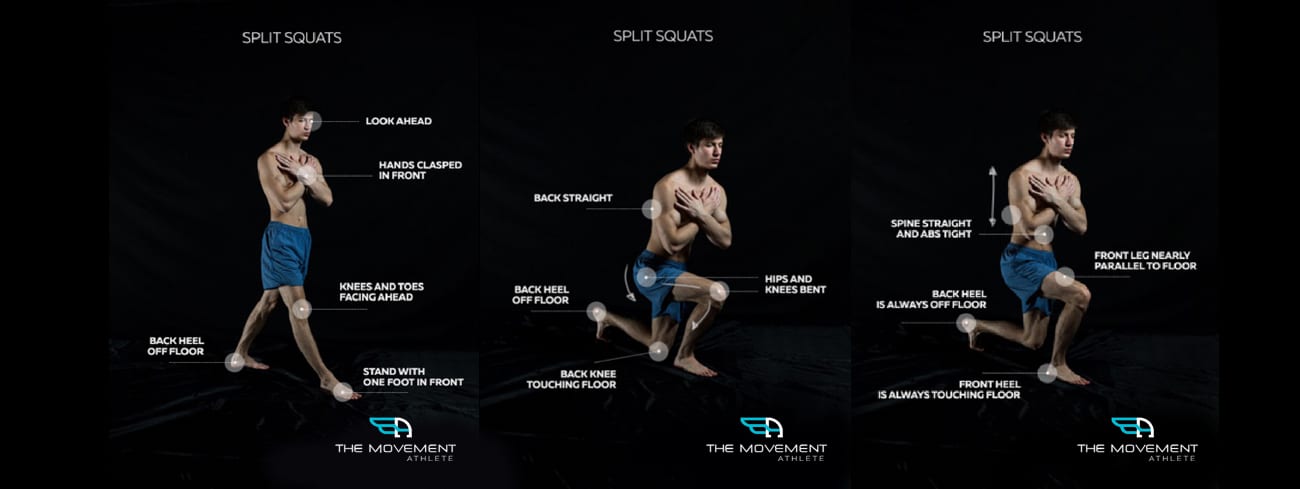
Perfect Form Checklist:
• Rear foot on bench/box 12-18 inches high
• Step forward 2-3 feet from bench
• Torso upright, core engaged
• Lower until back knee nearly touches floor
• Drive through front heel to return
• Keep front knee tracking over middle toe
3. JUMP LUNGES (Explosive Power)
Purpose: Build explosive power, increase vertical jump, burn calories
Primary Targets: Full leg musculature + plyometric power systems
Key Point: Land softly like a cat – control is everything
Athletic Transfer: Directly improves sprinting and jumping ability
Explosive Execution Guide:
• Start in deep lunge position (90° both knees)
• Explode upward driving both feet off ground
• Switch legs mid-air with control
• Land softly into opposite lunge position
• Immediately decelerate and repeat
• Focus on height, not speed initially
💪 Power Tip: Beginners start with alternating lunges, add the jump after mastering form.
4. PISTOL SQUAT (Ultimate Mastery)
Purpose: Ultimate test of strength, balance, mobility, and control
Requirements: Exceptional ankle mobility, hip flexibility, quad strength
Time to Master: 3-12 months depending on starting point
Athletic Benefits: Bulletproof knees, perfect balance, elite strength
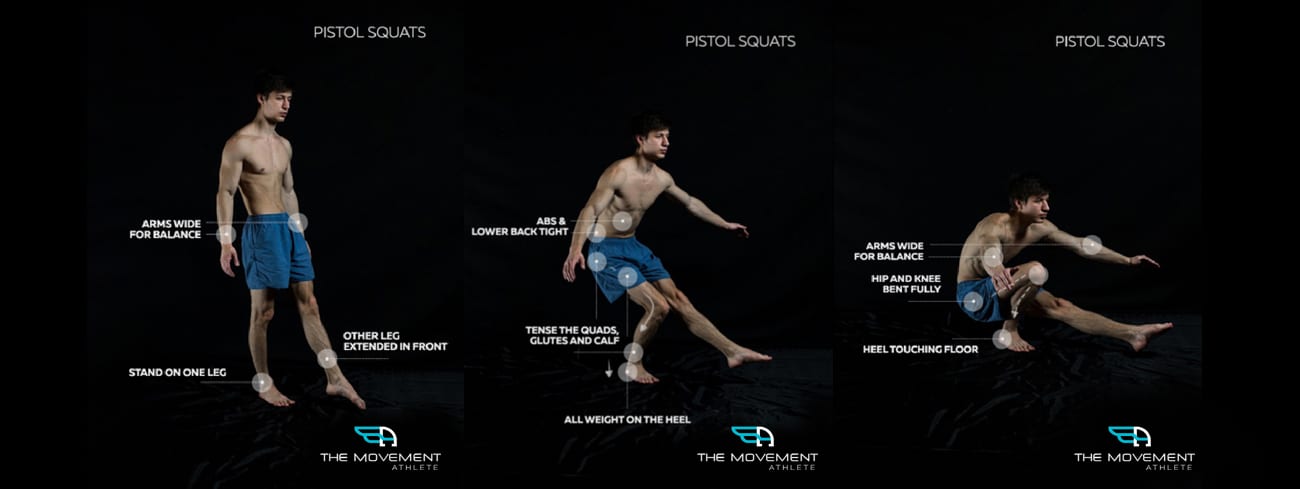
Progressive Mastery Path:
• Stage 1: Assisted pistol with TRX/pole
• Stage 2: Box pistol (partial range)
• Stage 3: Negative pistols (eccentric only)
• Stage 4: Full pistol squat
• Stage 5: Weighted pistol squat
• Stage 6: Jump pistol squat
💡 Mastery Secret: Work mobility daily – 90% of failures are flexibility, not strength.
Continue exploring exercises 5-10 including Nordic Curls, Box Jumps, Single-Leg RDLs, Shrimp Squats, Wall Sits, and Sprint Variations in our complete exercise library…
Frequently Asked Questions
Q: Can I really build big legs without weights?
A: Absolutely! Gymnasts and calisthenics athletes prove this daily. The key is progressive overload through harder variations, increased volume, and explosive movements. Studies show bodyweight training can produce similar hypertrophy to weight training when volume is equated.
Q: How often should I train legs for maximum growth?
A: For mass building, train legs 2-3x per week with at least one rest day between sessions. For strength/skill work, you can practice daily at lower intensities. Listen to your body and prioritize recovery.
Q: I can’t do a pistol squat. Where do I start?
A: Start with our assessment to find your exact level. Most people need to build up through: bodyweight squats → assisted pistols → box pistols → negative pistols → full pistol. Expect 3-6 months of consistent training.
Q: My knees hurt during squats. What should I do?
A: First, check your form – knees should track over toes, not cave inward. Second, work on ankle and hip mobility daily. Third, strengthen your glutes and hamstrings. If pain persists, consult a movement specialist. Never train through joint pain.
Q: How long until I see visible results?
A: With proper nutrition and training: Strength gains in 2-4 weeks, visible muscle in 6-8 weeks, significant size changes in 3-4 months. Consistency and progressive overload are key. Take progress photos!
👍 Your Legs Are Your Foundation – Build Them Right
Calisthenics can definitely help you build the tree trunk legs of your dreams, but it requires the same intensity and intelligence you bring to upper body work. The difference? When done right, bodyweight leg training builds not just mass, but incredible athleticism.
Remember: If you want to successfully achieve the planche or the human flag, you need your legs to be just as strong as your upper body. No exceptions.
About The Movement Athlete
The Movement Athlete (TMA) is the world’s leading AI-powered calisthenics coaching platform. Our team of expert coaches, sports scientists, and movement specialists have helped over 100,000 athletes build strength without weights.
Our Expertise:
• 15+ years combined coaching experience
• Published research in bodyweight training
• Certified in biomechanics and kinesiology
• Proven results with athletes at all levels
Related Articles You’ll Love:
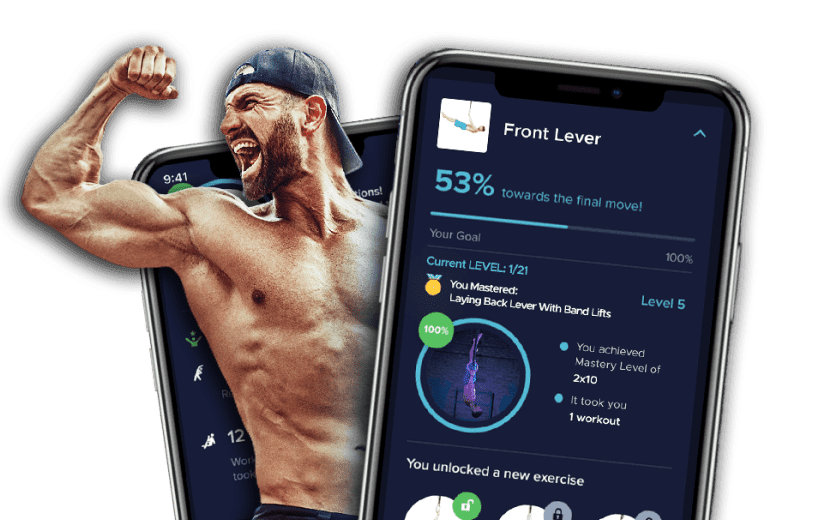
🔥 Limited Time: Free Assessment + 30-Day Trial
Stop Guessing. Start Building Tree Trunk Legs.
Get Your Personalized Leg Training Plan in 5 Minutes
⭐⭐⭐⭐⭐ Join 100,000+ athletes building strength with bodyweight
✅ Complete leg strength assessment
✅ Custom program for your exact level
✅ Progressive path to pistol squats
✅ Video demos for every exercise
✅ Track your tree trunk transformation
No credit card required • 5-minute assessment • Instant personalized plan
